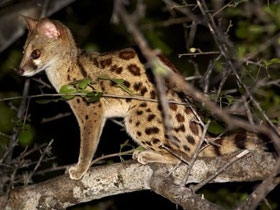The West African oyan or the West African linsang (Poiana leightoni)
The West African oyan (Poiana leightoni), also known as the West African linsang, is a linsang species native to the Upper Guinean forests in West Africa. It is one of the least known small carnivores in Africa.
Distribution
Poiana leightoni is a species of carnivorous mammal in the family Viverridae. It was formerly considered a subspecies of the African linsang Poiana richardsonii.
Poiana leightoni is a species of mammal in the wyvern family. It has only been confirmed from south-western Côte d'Ivoire (known from two records) and eastern Liberia (several records). Occurrence in south-west Guinea and Sierra Leone requires confirmation. Occurs in tropical forests.
Appearance
A small predator. Body length with head 30-38 cm, tail length 35-40 cm. Weight 500-700 g.
The body is relatively slender, with short limbs and long neck. The colour of the back and sides is reddish yellow, while the forelegs are greyish on the outside. The underside of the body, with the exception of the tail, is whitish, without spots. A band along the spine extends from the shoulders to the base of the tail. Spots are present on the sides, hips, shoulders and neck. The tail is longer than the head and body, fluffy and with 12-13 unequal blackish rings. The tip of the tail is yellowish, with flecks of ashy hairs.
Threats
The West African oyan is probably affected by habitat loss due to logging of tropical forests, and by hunting for bushmeat.
Taxonomy
The West African oyan was first described—in a paper read at the 26 November 1907 meeting of the Zoological Society of London and published the following May—by Reginald Innes Pocock, based on a zoological specimen collected in Liberia. Pocock considered it a subspecies of the Central African oyan, the trinomial in the original orthography being Poiana richardsoni leightoni, Poiana richardsoni liberiensis being printed in error. In 1974, Donovan Reginald Rosevear [de] elevated "Leighton's linsang" from subspecies to independent species rank
Threats to existence
The species is classified as Data Deficient; its main threats are loss of forest habitat and hunting for meat, probably inhabiting Sanbeam National Park in Côte d'Ivoire and Sapo National Park in Liberia.











































